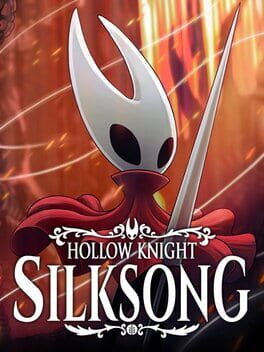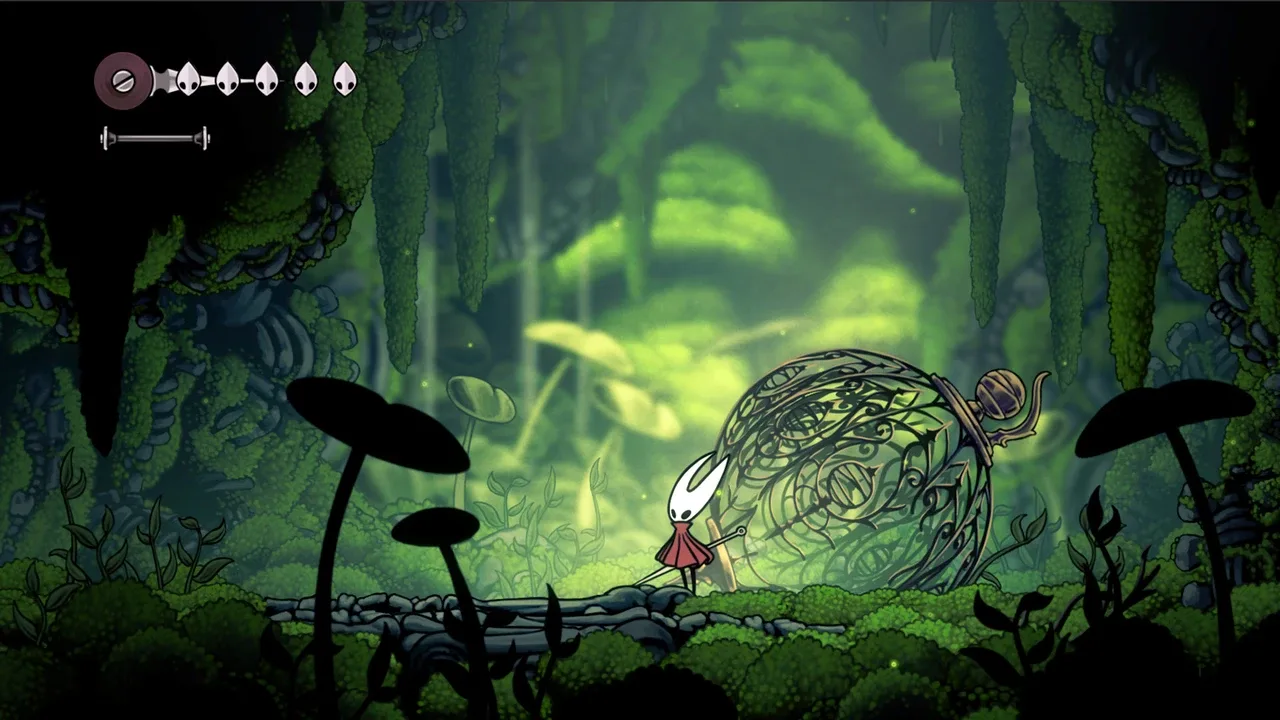in a better world, Hornet Silksong would be a woman who loves her pet dog so much her partner gets jealous. but instead she lives in a world where every god specifically chooses to make all dogs rabid
#hollow knight

-
-
 nex3 BACKER reviewed Hollow Knight: Silksong
nex3 BACKER reviewed Hollow Knight: Silksong This is an impressive follow-up to Hollow Knight not just in that it's another very good game (absolutely not a guarantee from a developer with only one game under their belt, no matter how successful that game was), but in that it understands deeply what makes a game effective specifically as a sequel. It's a checkerboard of expectations met and subverted: the core logic of the combat and feel of movement is essentially the same, but the single most powerful tool in HK1—the downward aerial "pogo" attack—is dramatically harder to use. Even early game bosses often do 2 masks of damage, but Hornet can heal three masks at a time. The familiar spell mechanic is back (renamed "skills" but otherwise identical) but it's augmented with equippable weapons that use a totally new economy.
This is an impressive follow-up to Hollow Knight not just in that it's another very good game (absolutely not a guarantee from a developer with only one game under their belt, no matter how successful that game was), but in that it understands deeply what makes a game effective specifically as a sequel. It's a checkerboard of expectations met and subverted: the core logic of the combat and feel of movement is essentially the same, but the single most powerful tool in HK1—the downward aerial "pogo" attack—is dramatically harder to use. Even early game bosses often do 2 masks of damage, but Hornet can heal three masks at a time. The familiar spell mechanic is back (renamed "skills" but otherwise identical) but it's augmented with equippable weapons that use a totally new economy.
The result is a game that presents the player, from the moment they first try platforming with the new diagonal aerial attack, with a potent cocktail of familiarity and challenge. This proved too much for players who expected their skill at HK1 to automatically make them excellent at Silksong, but it's excellent design. A new game should challenge old players, and when those challenges subvert the best play patterns in the first game, they increase the challenge more for experienced players than they do for players who (perhaps boldly) pick up Silksong as their first entry in the series. Silksong demands that the player adapt to new styles of movement and resource economies, but at its heart it's still a game about careful positioning and weaponized acrobatics.
So, is it hard? Not really. For all the hullabaloo on release about how difficult Silksong is, the main difference between its main quest bosses and Hollow Knight's are that the early-game bosses are somewhat harder, which is about what one would expect from a sequel. Once you get past the first few intro bosses, you end up at around the level of HK1 bosses in similar positions like Mantis Lords, Soul Master, and of course our very own Hornet. Even the optional bosses are mostly pretty straightforward, with only a couple exceptions. The mandatory platforming is a little more difficult across the board than HK1, in part because of the less forgiving pogo and a larger suite of movement mechanics, but there's no single sequence mandatory or optional that comes close to the sustained difficulty of Path of Pain. If anything, I wish there were a bit more difficulty in the game, and I'm hoping the DLC will provide that.
What people are complaining about, when it comes down to it, is that the game demands they break out of their comfort zone. And it makes some sense! The most diehard Hollow Knight players have been building their mental model of what being good at Hollow Knight entails unhindered for eight years. Every Hollow Knight DLC introduced new challenges that tested the same skills but harder. Silksong asks for more, or at least for a reframing of the way players think about the game.
Nowhere is this clearer than in the removal of the Shade Cloak, and with it the elimination of almost any form of invulnerability-frame evasion in the game. By volume, this wasn't a huge part of the base game—it's an ability you only get in the postgame, so the bulk of the fights you face won't involve it at all. But the postgame fights and many of the DLC fights, which is to say generally the most difficult fights in the game, are built with the expectation that you'll be able to occasionally dodge right through an attack. Silksong has no such expectation, and I think that's tremendously to its credit even as it drives experienced Hollow Knight players mad.
Removing the expectation that players can regularly dodge through the attacks of postgame bosses makes the design and play of those fights vastly more interesting. Dodging attacks through careful positioning brings all the game's movement mechanics to bear in fights, and is what makes the marriage of platforming and action combat so successful. Combined with the substantial wider diversity of directionality in Silksong's attacks relative to the base game, it gives fights the potential to be very deep puzzles about how to most effectively deal damage without taking it. This is all inherent in Hollow Knight as well, but the Shade Cloak offered a safety valve for players to avoid engaging with it in exactly the fights where it was most compelling. Silksong is richer for its absence, and I think this particularly speaks to Team Cherry's maturing understanding of what's effective about their own design. -
Power, Skill, and Silksong
While this blog post does contain specific mechanical spoilers about Hollow Knight: Silksong, they're only at the very end, clearly marked, and hidden by default. Most of the post is spoiler-free.
Many games, video and otherwise, are structured in a way that presents the player with both challenges tools they can use to address those challenges. In video games specifically, much hay is made online of the challenges themselves: everyone talks about Ornstein and Smough, Absolute Radiance, or Balteus. But to the player in the moment, the shape of the tools they use determines as much or more about their actual experience.
Tools aren't just in-game items. They're anything that aids the player or allows them to engage with the game, from their character's stats to movement mechanics to the very concept of "make your character not be where the attack is". In sports, the players themselves are the most important tools. In chess, the pieces are tools but so are rules castling and stalemates. It's an intentionally broad term to discuss a broad set of game structures.
These tools are not only the ultimate determiner of how difficult the challenge is[1], a well-designed arsenal gives players the opportunity to sculpt their experience, creating a mode of play that fits both the needs of the challenge at hand and their own personal preference. Often players end up self-sorting into two rough camps: those who choose one set of tools (a "build") and stick with it for every challenge and so experience challenges that may be easy for others as very difficult when the tools they've chosen don't line up well, and those who see each challenge as an opportunity to puzzle out the exact optimal set of tools and so take down the challenge as easily as possible. I myself fall into either camp depending on the specific context[2].
One of the first thing a player will ask when choosing which tools to use is, "what's the most powerful?" And in some cases the answer to this is straightforward. In Dark Souls, the Straight Sword Hilt is certainly among the weakest weapons you can use by any objective measure. But in many cases the answer is unclear. There is no consensus "best" weapon in Dark Souls nor its successors, because what "power" even means depends on the player's play style, their goals, and to a substantial degree, their skill.
Defining Skill
I want to take a moment here to clarify what I mean by "skill", at least for the purposes of this post. I don't really want to get into the weeds discussing video game difficulty here and now, but I do think that discourse has made it difficult to mention skill as a concept without raising everyone's hackles and bringing in a bunch of extra baggage. So I'll try to be explicit about how I'm using the term here.
I'm not talking about skill as in some sort of innate talent at video…